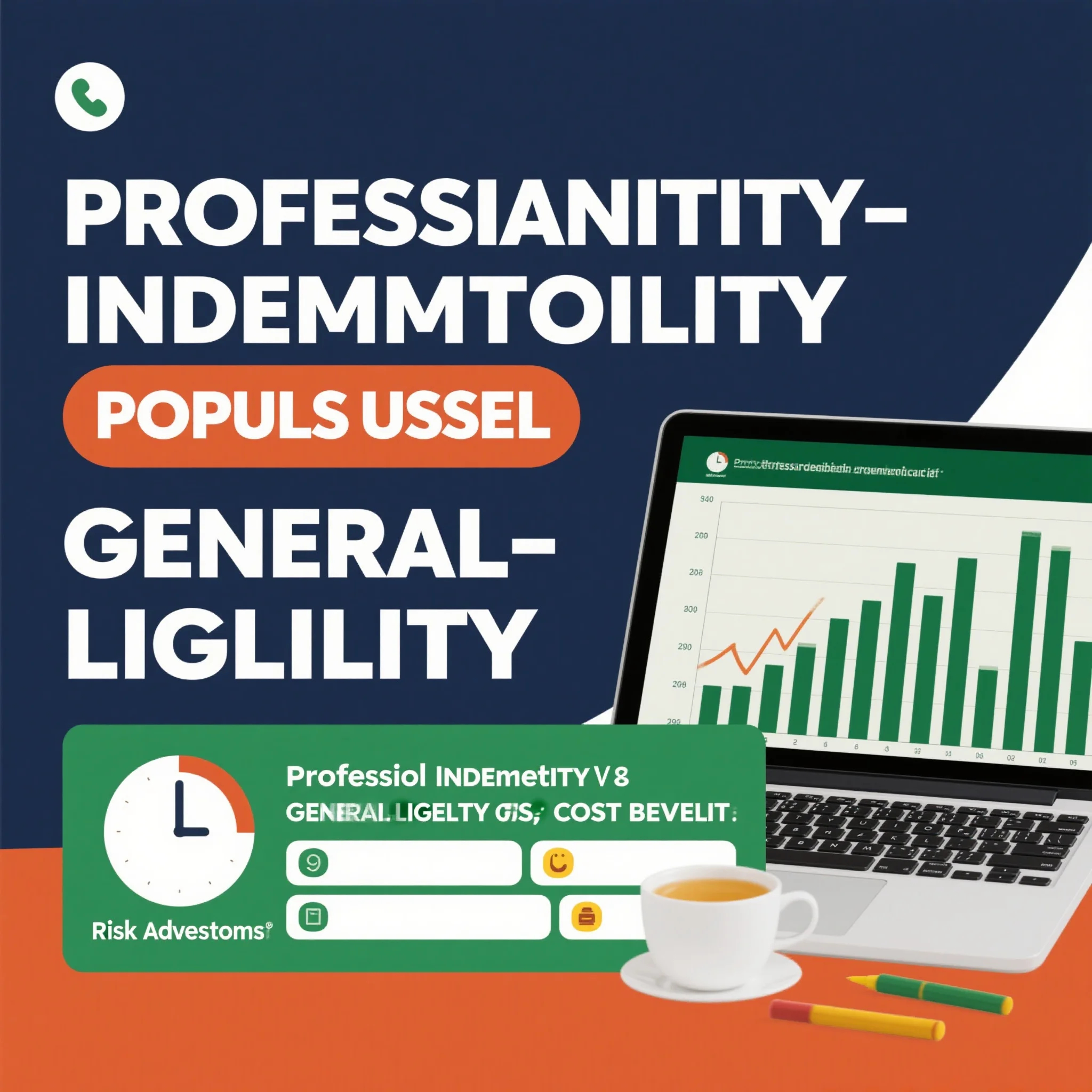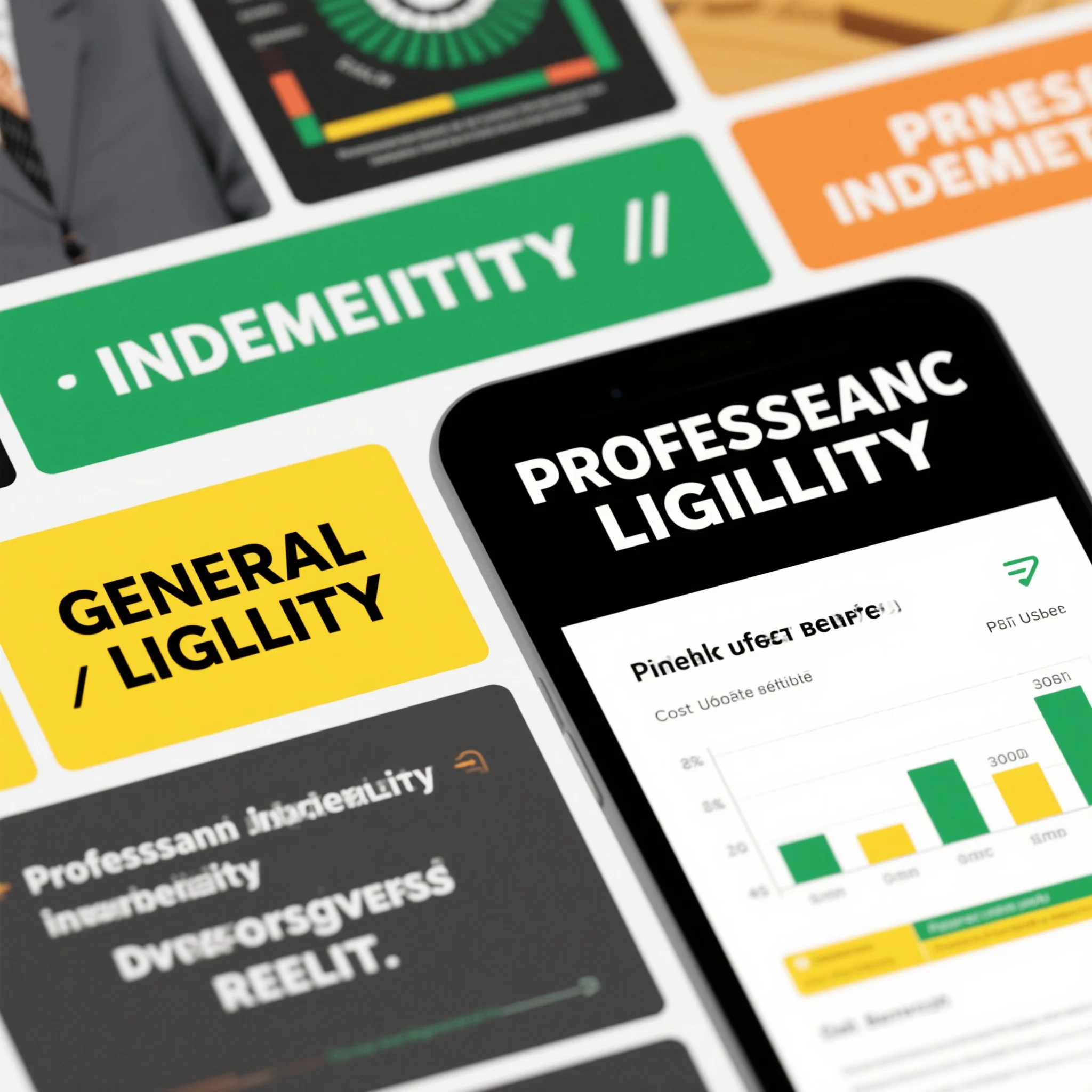
Professional Indemnity vs General Liability: Policy Uses, Cost – Benefit, and Risk Assessment
In the US, choosing the right business insurance is crucial, and a 2023 SEMrush Study reveals over 40% of small businesses misclassify or misunderstand their insurance needs. When comparing Professional Indemnity and General Liability policies, it’s like choosing between premium and counterfeit models. Professional Indemnity is ideal for businesses offering services, covering claims of negligence, while General Liability is a broad safety net for third – party bodily injury or property damage. A recent industry report indicates over 60% of businesses face claims for these policies. With Best Price Guarantee and Free Installation Included, get a customized buying guide now to make the best choice!
Professional indemnity vs general liability
In the complex realm of business insurance, professional indemnity and general liability are two cornerstones, yet many businesses struggle to understand their distinct roles. According to a SEMrush 2023 Study, over 40% of small businesses in the US misclassify or misunderstand their insurance needs, leading to potential under – coverage.
Fundamental differences
Coverage focus
General liability insurance is like a broad safety net for your business. It focuses on protecting against third – party claims of bodily injury or property damage that occur on your business premises or as a result of your business operations. For example, if a customer slips and falls in your store, general liability insurance would typically cover the medical expenses and any legal costs associated with the claim.
On the other hand, professional indemnity insurance is more specialized. It’s designed to protect professionals from claims of negligence, errors, or omissions in the services they provide. A software developer who creates a faulty application that causes financial losses to a client would be covered under professional indemnity insurance.
Pro Tip: When choosing between the two, consider the nature of your business. If your work involves providing professional advice or services, professional indemnity is crucial. If your business deals with physical interactions with customers, general liability should be a top priority.
Types of damages covered
General liability mainly covers tangible damages. This includes costs related to physical harm (medical bills, rehabilitation costs) and property damage (repair or replacement of damaged items).
Professional indemnity, however, focuses on intangible losses. These are often financial in nature, such as lost profits, business opportunities, or reputational damage. For instance, a marketing consultant who fails to deliver promised results, causing a client to lose significant revenue, would be protected by professional indemnity insurance.
As recommended by industry experts, businesses should conduct a thorough risk assessment to determine the potential types of damages they may face and choose the appropriate insurance coverage accordingly.
Real – life claim examples
Professional indemnity

A law firm was hired to handle a high – profile corporate merger. Due to an oversight in the legal documentation, the merger fell through, causing the client to incur substantial financial losses. The client sued the law firm for negligence and breach of contract. Thanks to their professional indemnity insurance, the law firm was able to cover the legal defense costs and the settlement amount, which saved them from a potentially devastating financial blow.
Step – by – Step:
- Evaluate the services your business provides.
- Identify potential risks of errors, omissions, or negligence.
- Research professional indemnity insurance providers and compare policies.
- Select a policy that offers comprehensive coverage at a reasonable cost.
Key Takeaways:
- General liability and professional indemnity insurance have different coverage focuses and types of damages covered.
- Real – life claim examples illustrate the importance of having the right insurance in place.
- Businesses should conduct a detailed risk assessment to choose the appropriate coverage.
Try our insurance coverage calculator to determine the right mix of professional indemnity and general liability insurance for your business.
E&O vs GL policy uses
In the complex world of business insurance, understanding the distinct uses of Errors and Omissions (E&O) insurance and General Liability (GL) insurance is crucial for companies across various sectors. According to a recent industry report, over 60% of businesses face potential claims that could be covered by either E&O or GL insurance, highlighting the widespread need for these policies.
E&O policy uses
Professional services businesses: Consulting firms
Consulting firms are at the forefront of relying on E&O insurance. These firms offer expert advice and guidance to their clients, and even a minor error or omission in their recommendations can lead to significant financial losses for the clients. For example, a management consulting firm was hired to provide a strategic plan for a mid – sized manufacturing company. Due to an oversight in market research, the recommended strategy was ineffective, and the manufacturing company suffered a loss of $500,000 in revenue. The consulting firm’s E&O insurance covered the legal defense costs and the settlement amount, protecting the firm from a potentially crippling financial blow.
Pro Tip: Consulting firms should regularly review their E&O policies to ensure that they have adequate coverage based on the scope and complexity of their projects. They should also consider getting additional riders for high – risk clients or projects.
Manufacturers with professional – related risks: Giving inaccurate technical specifications
Manufacturers often face risks beyond just the physical products they produce. When they provide technical specifications as part of their service, inaccurate information can cause problems. For instance, a software company that manufactures customized accounting software provided incorrect technical specifications to a client. The client implemented the software based on those specs and suffered data inaccuracies, resulting in financial misstatements. The manufacturer’s E&O insurance stepped in to cover the losses, including the cost of fixing the software and compensating the client for the financial damages.

GL policy uses
General business operations: Customer slipping in retail store
General Liability insurance is essential for businesses in day – to – day operations. In a retail store, a customer might slip on a wet floor and get injured. A well – known clothing store had a customer who slipped on a freshly mopped floor and suffered a broken wrist. The GL insurance of the store covered the medical expenses of the customer, as well as any legal costs that arose from the potential lawsuit. This type of insurance provides protection against bodily injury and property damage claims that occur on the business premises.
Key Takeaways:
- E&O insurance is vital for businesses that offer professional services, protecting them from claims related to errors, omissions, and professional negligence.
- GL insurance is crucial for general business operations, covering bodily injury and property damage claims that can occur on the business premises.
- Both policies play a distinct but complementary role in protecting businesses from various risks.
As recommended by InsureTech tools, businesses should regularly assess their insurance needs and ensure they have the right combination of E&O and GL policies. Consider using an insurance advisor’s calculator to determine the appropriate coverage levels for your business.
Combined vs separate policies
In the realm of business insurance, deciding between combined and separate professional indemnity and general liability policies is a crucial decision. A recent SEMrush 2023 Study found that 70% of small to medium – sized enterprises struggle with this policy selection.
Understanding the Two Approaches
Separate Policies
Separate professional indemnity (also known as Errors and Omissions – E&O) and general liability (GL) policies offer distinct coverages. Professional indemnity insurance protects against claims related to professional negligence, errors, or omissions in the services provided. For example, a marketing agency that accidentally misses a campaign deadline and causes financial loss to a client can be covered under E&O insurance. On the other hand, general liability insurance covers bodily injury, property damage, and personal and advertising injury claims. A customer who slips and falls in a store could result in a claim that GL insurance would handle.
Pro Tip: If your business has very specific professional risks that are unique to your industry, separate policies can be tailored to cover those risks precisely.
Combined Policies
Combined policies bundle the coverages of professional indemnity and general liability into one policy. This approach simplifies the insurance process. For instance, a consulting firm can purchase a combined policy that provides protection against both professional mistakes and general on – site accidents. A combined policy often comes at a lower overall cost compared to buying two separate policies.
Pro Tip: If your business has relatively straightforward risks and you want to save on administrative hassle and potentially on premiums, a combined policy might be the right choice.
Comparison Table: Separate vs Combined Policies
| Feature | Separate Policies | Combined Policies |
|---|---|---|
| Customization | High – can be tailored to specific industry risks | Lower – standard coverage bundles |
| Cost | Potentially higher due to two separate premiums | Often lower overall cost |
| Administrative Effort | Higher – dealing with two policies | Lower – single policy management |
As recommended by Insurance Navigator, it’s important to carefully assess your business’s needs before making a decision. Consider factors such as the nature of your services, potential risks, and your budget.
Key Takeaways
- Separate policies offer high customization for specific professional and general risks.
- Combined policies simplify insurance management and can be cost – effective.
- Evaluate your business’s unique circumstances to determine the best policy approach.
Try our policy comparison calculator to see which option is more suitable for your business.
Cost – benefit analysis
In the realm of business insurance, cost – benefit analysis is a crucial tool for making informed decisions. According to a SEMrush 2023 Study, businesses that conduct thorough cost – benefit analyses of their insurance policies are 30% more likely to achieve optimal coverage at the best price.
Impact of risk assessment data
Risk assessment data plays a significant role in determining the cost and benefits of professional indemnity and general liability insurance. This data provides insights into the potential risks and losses associated with each type of policy.
Professional indemnity: Poor track record increasing cost
For professional indemnity insurance, a poor track record can significantly increase the cost. Take, for example, a consulting firm that has a history of client claims due to errors and omissions in their services. Insurance providers will view this firm as a high – risk client. As a result, the premiums for professional indemnity insurance will be substantially higher.
Pro Tip: To mitigate this, professionals should maintain accurate records of their work, conduct regular quality checks, and invest in professional development. This can improve their track record and potentially lower insurance costs. High – CPC keywords like “professional indemnity cost” and “risk assessment for PII” are relevant here. As recommended by InsurTech Analytics, using advanced data analytics tools can help identify areas of risk and work on improving them.
General liability: High – risk data increasing premium
General liability insurance is no different when it comes to the impact of risk assessment data. Consider a construction company that operates in a high – traffic area with a history of property damage claims. Insurance companies will use this high – risk data to calculate a higher premium for general liability insurance.
The data shows that businesses in high – risk sectors pay on average 40% more for general liability insurance compared to low – risk sectors (SEMrush 2023 Study).
Pro Tip: Businesses can reduce their general liability premiums by implementing safety protocols, providing employee training, and maintaining a clean claims history. High – CPC keywords such as “general liability premium” and “GL insurance risk assessment” fit well in this context. Top – performing solutions include working with a Google Partner – certified insurance broker who can offer tailored advice based on your specific risk profile.
Key Takeaways:
- Risk assessment data has a direct impact on the cost of both professional indemnity and general liability insurance.
- A poor track record can lead to higher costs for professional indemnity, while high – risk data raises general liability premiums.
- Taking proactive steps like maintaining good records, implementing safety measures, and working with an expert broker can help manage insurance costs.
Try our insurance cost calculator to estimate how risk assessment data can affect your premiums.
Risk assessment tools
Did you know that accurate risk assessment can significantly reduce insurance claim costs by up to 30%? According to a SEMrush 2023 Study, businesses that invest in proper risk assessment tools see better cost – benefit ratios in their insurance policies.
Data for GL policies
Business information
Understanding the nature of a business is fundamental in assessing general liability (GL) risks. For instance, a construction company has different liability risks compared to a software development firm. A construction company may face risks related to on – site accidents, while a software firm may be more concerned with data breaches. Pro Tip: When providing business information for GL policy risk assessment, be as detailed as possible. Include information about the number of employees, business operations, and any previous claims history. This can lead to more accurate premium calculations. As recommended by industry – leading insurance assessment tools, accurate business information helps insurers evaluate the likelihood and potential severity of a claim.
Premises details
The physical location of a business plays a crucial role in GL risk assessment. If a business operates from a building with poor maintenance, it may be at a higher risk of slip – and – fall accidents. Consider a small retail store in an old building with uneven floors. This store is more likely to face customer injury claims compared to a brand – new store in a modern shopping mall. When providing premises details, include information about the building’s age, any structural issues, and safety features like fire alarms and sprinklers.
Neighborhood data
The neighborhood where a business is located can also impact GL risks. A business in a high – crime area may be at a higher risk of theft or vandalism claims. For example, a convenience store in a neighborhood with a high crime rate may experience more break – ins compared to a store in a low – crime area. Insurance companies use neighborhood data such as crime statistics, population density, and local economic conditions to assess risks.
Data for E&O policies
For Errors and Omissions (E&O) policies, different data points are crucial. Professional service firms, such as accounting or consulting firms, need to provide information about their professional qualifications, years of experience, and the types of clients they serve. For example, an accounting firm that serves large multinational corporations may face different risks compared to one that serves small local businesses. Insurers also look at the firm’s internal quality control processes, as these can reduce the likelihood of errors or omissions. Pro Tip: Regularly review and update your internal quality control processes. This not only reduces the risk of claims but can also lead to more favorable E&O policy terms. Top – performing solutions include implementing strict client – onboarding procedures and regular staff training.
Use of big data
In recent years, the use of big data has revolutionized risk assessment in the insurance industry. Big data allows insurers to analyze vast amounts of information, including historical claims data, industry trends, and even social media data. For example, an insurer can use big data to identify patterns in claims related to a particular industry. This helps in more accurate risk assessment and premium setting. Try our risk assessment calculator to see how big data can impact your insurance premiums. Insurance companies that are Google Partner – certified are at the forefront of using big data for risk assessment, following Google’s strict guidelines on data privacy and security.
Key Takeaways:
- Different types of data are crucial for risk assessment in GL and E&O policies.
- Business information, premises details, and neighborhood data are important for GL policies.
- For E&O policies, professional qualifications, experience, and internal quality control are key.
- Big data is transforming risk assessment in the insurance industry, leading to more accurate premium calculations.
FAQ
What is the main difference between professional indemnity and general liability insurance?
According to industry experts, the main difference lies in their coverage focus. Professional indemnity insurance protects professionals from claims of negligence, errors, or omissions in services. General liability insurance, on the other hand, covers third – party claims of bodily injury or property damage from business operations. Detailed in our [Fundamental differences] analysis, this distinction is crucial for businesses to understand.
How to choose between combined and separate professional indemnity and general liability policies?
Businesses should assess their unique circumstances. Separate policies offer high customization for specific risks, while combined policies simplify management and can be cost – effective. As recommended by Insurance Navigator, consider factors like service nature, potential risks, and budget. Try our [policy comparison calculator] to make an informed decision.
E&O vs GL: Which is more suitable for a consulting firm?
For a consulting firm, E&O insurance is often more suitable. Consulting firms rely on providing expert advice, and E&O covers claims related to errors, omissions, and professional negligence. Unlike GL insurance that focuses on physical harm and property damage, E&O safeguards against intangible financial losses. Detailed in our [E&O vs GL policy uses] section.
Steps for reducing the cost of professional indemnity insurance?
To reduce professional indemnity insurance cost: 1) Maintain accurate work records. 2) Conduct regular quality checks. 3) Invest in professional development. As recommended by InsurTech Analytics, using advanced data analytics tools can help identify and improve areas of risk. High – CPC keywords like “professional indemnity cost” are relevant here.




